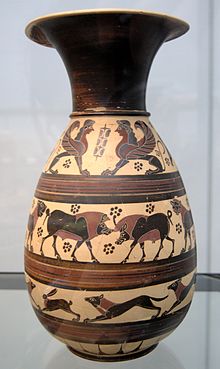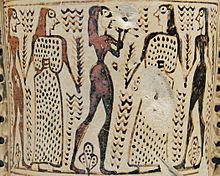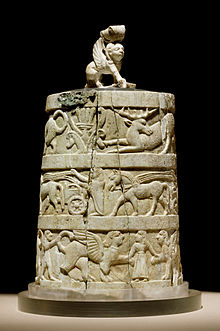
Back فترة الاستشراق Arabic Арыенталізавальны стыль Byelorussian Ориентализиращ период Bulgarian Període orientalitzant Catalan Orientalisierende Periode German Período orientalizante Spanish Ekialdekotze aldi Basque Orientalisoiva kausi Finnish Époque orientalisante French Período orientalizante Galician




In the Archaic phase of ancient Greek art, the Orientalizing period or Orientalizing revolution (also spelled "Orientalising") is the cultural and art historical period that began during the later part of the 8th century BC, when there was a heavy influence from the more advanced art of the Eastern Mediterranean and the Ancient Near East. The main sources were Syria and Assyria as well as Phoenicia and Egypt.[1][2] With the spread of Phoenician civilization by Carthage and Greek colonisation into the Western Mediterranean, these artistic trends also influenced the Etruscans and early Ancient Romans in the Italian peninsula.
- ^ Robert Manuel Cook, Pierre Dupont, East Greek Pottery, Routledge, 1998 pp. 29ff.
- ^ Robert Manuel Cook, Greek Painted Pottery, Routledge, 3rd edition (1997), p. 41: "The technique of these works is generally incompetent, their style often a stale and varying medley of the traditional Hittite, Assyrian and Egyptian elements that were currently available in North Syria."
© MMXXIII Rich X Search. We shall prevail. All rights reserved. Rich X Search